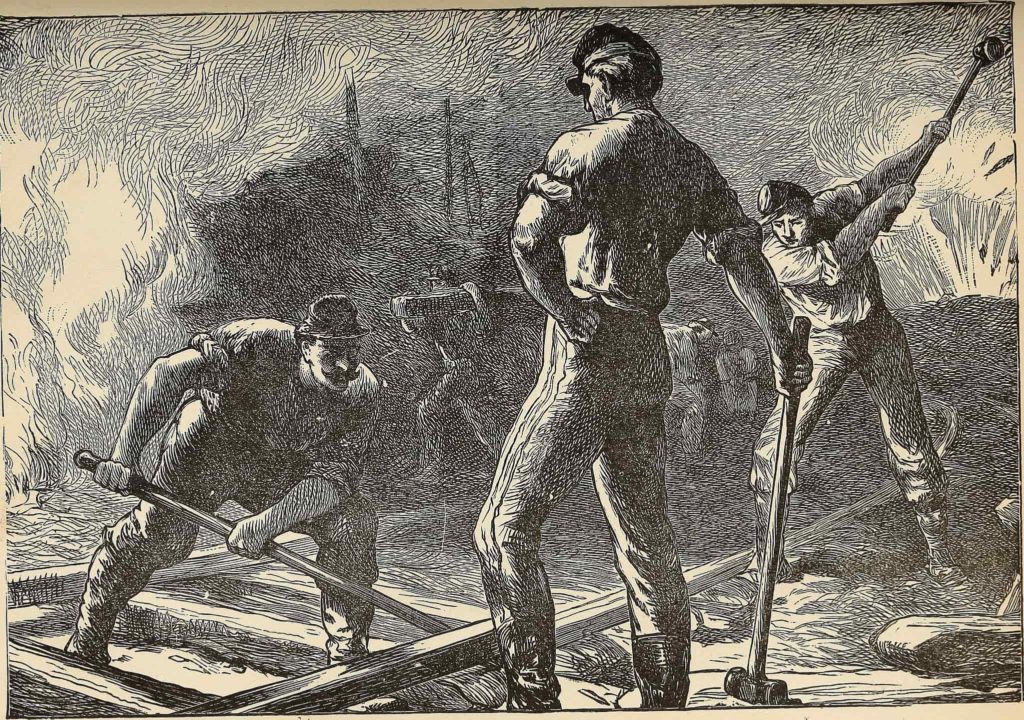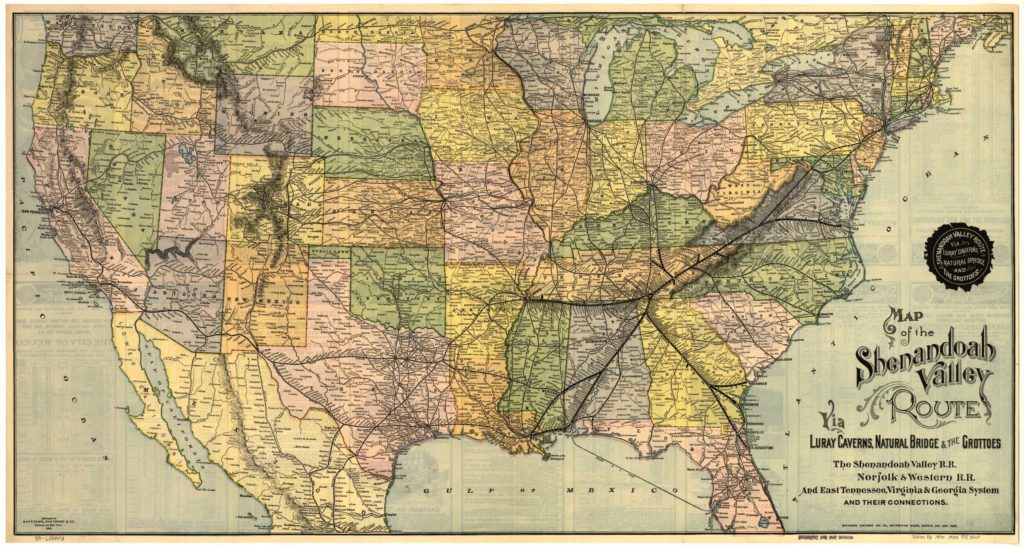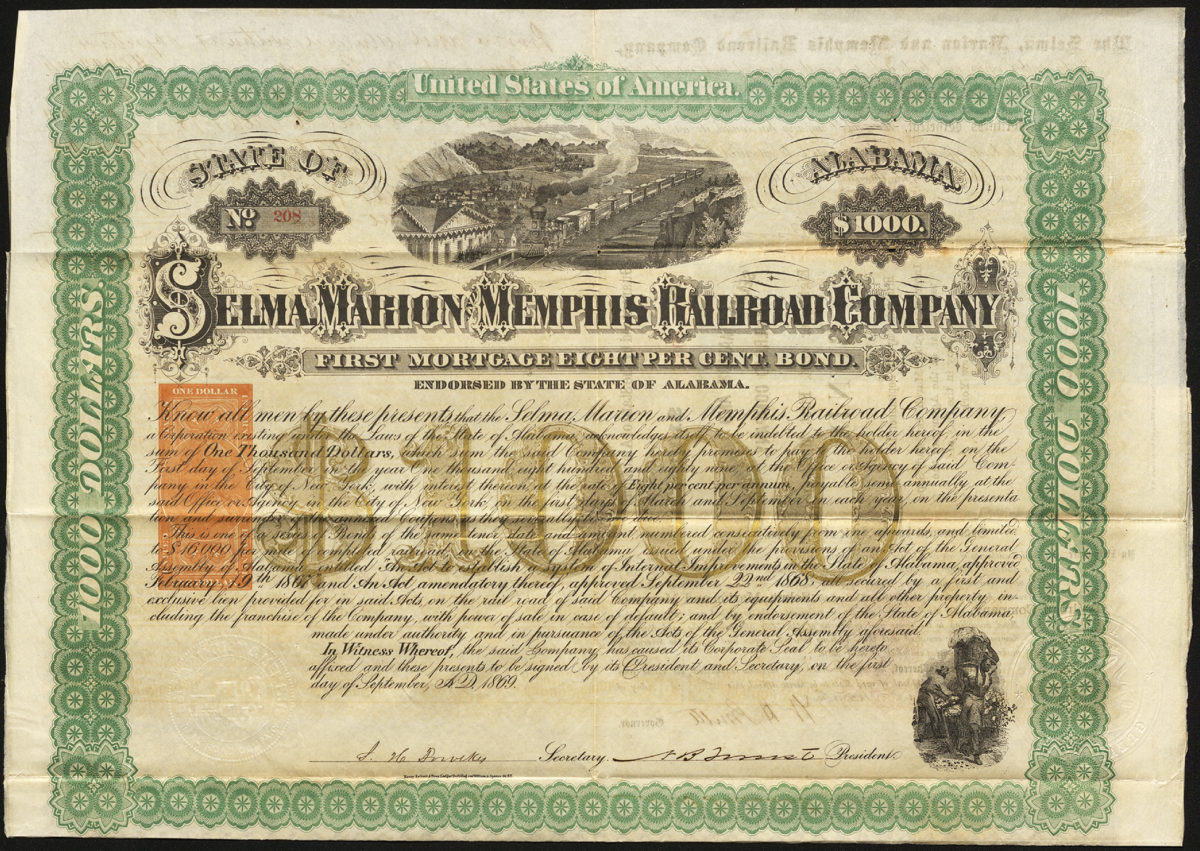
Nathan Bedford Forrest: Reconstruction of the Confederate Railroads
After railroads were destroyed from the Civil War, reconstruction of the South emphasized infrastructure re-builds. This Selma, Marion and Memphis Railroad certificate represented Alabama’s Reconstruction focus and is signed by disputable Alabama Governor William Hugh Smith and company president and Ku Klux Klan founding member Nathan Bedford Forrest.
Header Image: Union forces tear up the rails in Charlottesville, North Carolina; author Charles Carleton Coffin courtesy Wikimedia Commons [1].
“That devil Forrest must be hunted down and killed if it costs ten thousand lives and bankrupts the federal treasury.”

The railroad network in the American south, 1890; courtesy Library of Congress
Following the American Civil War, the Reconstruction Era began, and the State of Alabama took on millions of dollars’ worth of bonded debt to make internal improvements. One of the highest priorities was the development of the state’s railroad system. This 1869 bond for a private railroad company has been endorsed by William Hugh Smith, Alabama’s governor at the time. His signature is on the back and can be seen bleeding through in the lower right-hand corner. By endorsing this bond, Smith was agreeing that the State of Alabama itself was bound to repay investors.
William Hugh Smith served as governor of Alabama from 1868-1870. He had been a slave-owner prior to the war but opposed the secessionist movement on practical grounds rather than on a moral basis. His governorship would later be tainted by his lenient attitude towards the Ku Klux Klan, though financial scandal connected to railroad bond debt was the main reason Smith failed to win re-election. When he entered office, the improvement of Alabama’s railroad infrastructure had bipartisan support and was key to the economic recovery of the state. Actual implementation of this economic policy was sorely mismanaged; the government overextended its obligations, which ultimately contributed to the economic collapse of the state. Smith was accused of fraud and corruption, as he had received contributions from directors of railroads and was among many politicians who had benefited from their ownership in railroad companies.
As controversial a figure as William Hugh Smith was, another signature on this bond overshadows him: Nathan Bedford Forrest, who has signed as president of the Selma, Marion and Memphis Railroad Company. Forrest had been born into poverty but worked to become a wealthy businessman who owned several cotton plantations in Tennessee, invested in real estate, sold livestock, and traded slaves. Forrest enlisted in the Confederate Army in 1861 and rapidly rose through the ranks to become a lieutenant general—and one of the most feared, at that. In 1864, Union General William T. Sherman famously declared, “That devil Forrest must be hunted down and killed if it costs ten thousand lives and bankrupts the federal treasury.” (Scroll down to continue reading about the Selma, Marion and Memphis Railroad below)
Following defeat in the Civil War, Nathan Bedford Forrest returned home to regroup; the abolition of slavery undermined both his cotton plantations and his slave-trading business in Memphis. However, he quickly became involved in the railroad industry as a result of his experiences in Alabama during the war. He believed that there was need for a railroad line connecting the cotton-producing regions of Alabama to markets in Memphis. He became president of the Selma, Marion and Memphis Railroad in 1868 and raised funds for the construction of this line through Alabama’s internal improvement program. This bond is decorated with vignettes that reflect Forrest’s vision: at top, a train pulls into a station in a genteel rural community; at the bottom right, African field hands pick and fill bushels of cotton.
Unfortunately, Forrest was not as talented in railroading as he had been in the war. The company was driven into bankruptcy during the financial Panic of 1873, which was spurred in part by over-investment in railroads. Only seven of the original forty interest coupons attached to this certificate have been redeemed, likely because the company became insolvent in 1873.
Forrest is still fondly remembered in the South and Civil War history for his talents as a commanding officer. Even General Sherman conceded that Forrest was “the most remarkable man our Civil War produced on either side.” His legacy is apparent on the landscape, in the form of monuments and place names like Nathan Bedford Forrest State Park.
Though some view him as a hero of the war, he was on the wrong side of history and further cemented his reputation through his actions. Forrest led the troops that committed the Fort Pillow Massacre in 1864, where over three hundred Union soldiers—the majority of them African American—were killed after surrendering to Confederate forces. After the war, Forrest was among the founding members of the Ku Klux Klan. As Forrest was nicknamed the “Wizard of the Saddle” during the war, it is perhaps no coincidence that ‘wizard’ became a title in the organization.
 University of Nevada, Reno
University of Nevada, Reno
